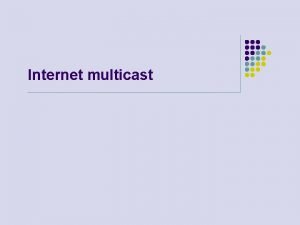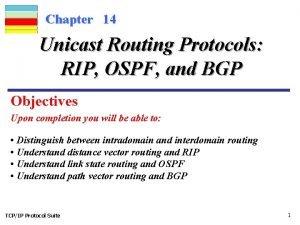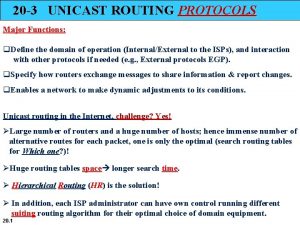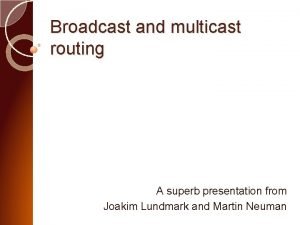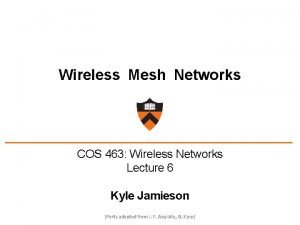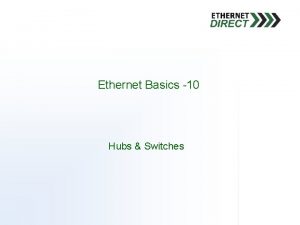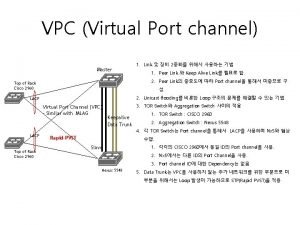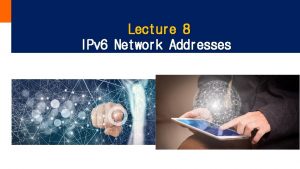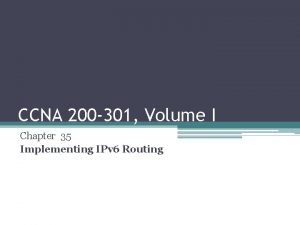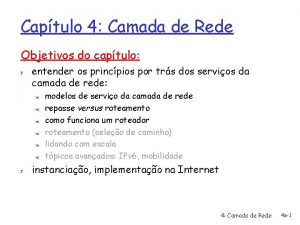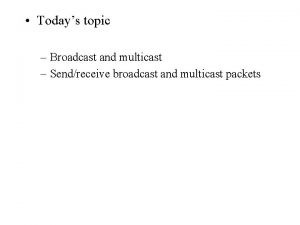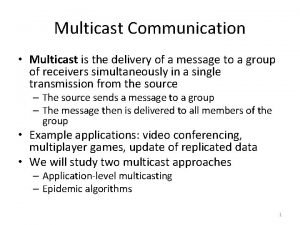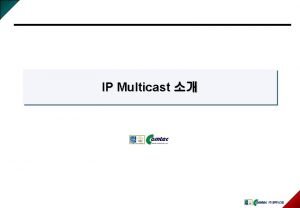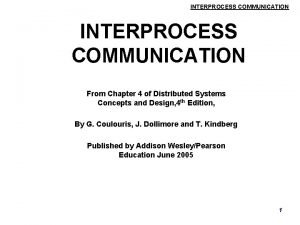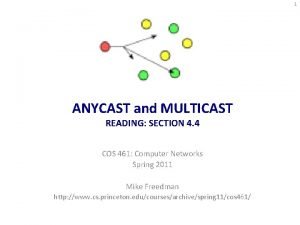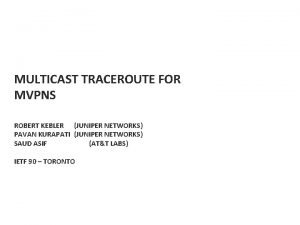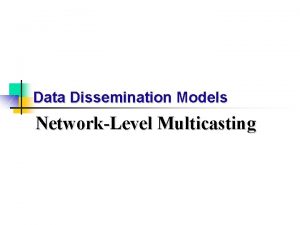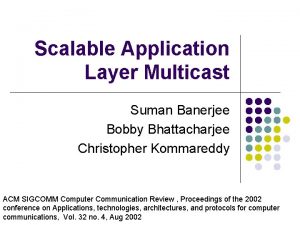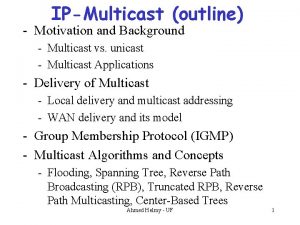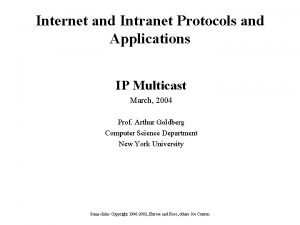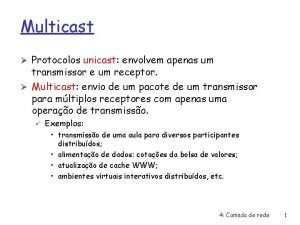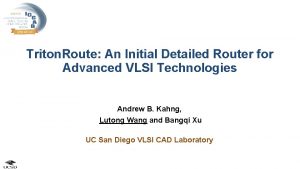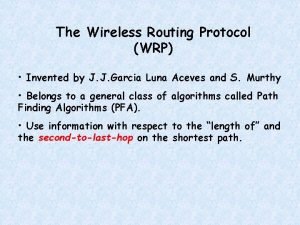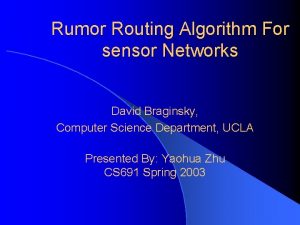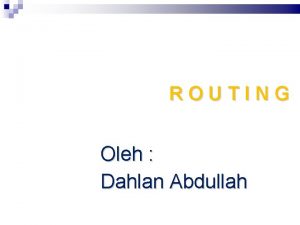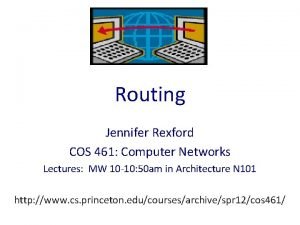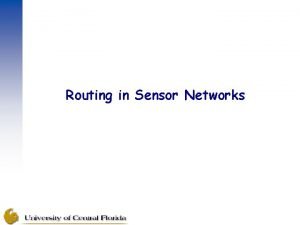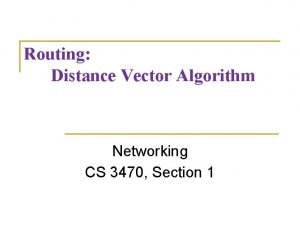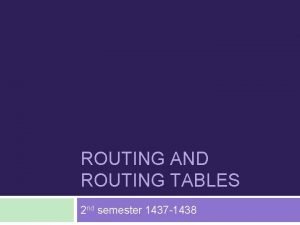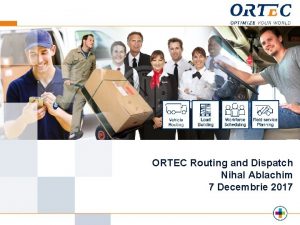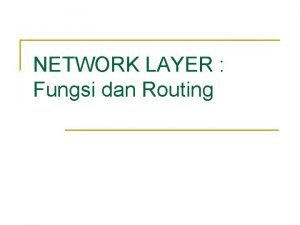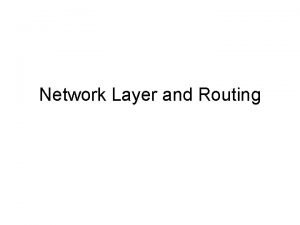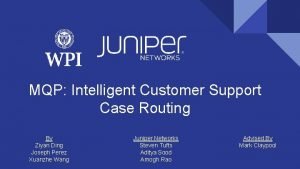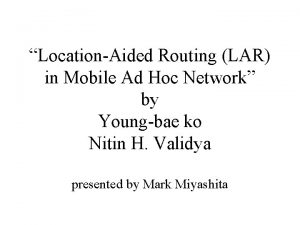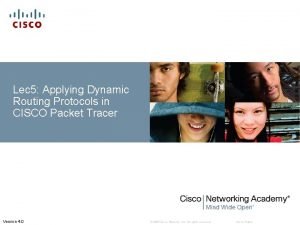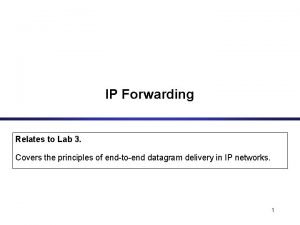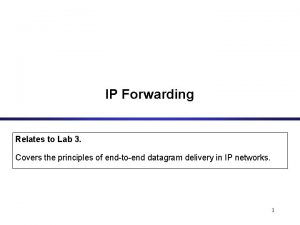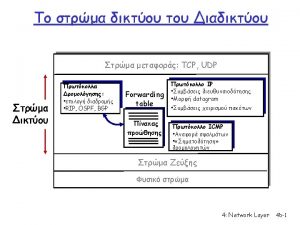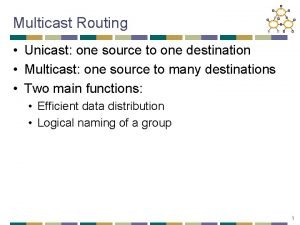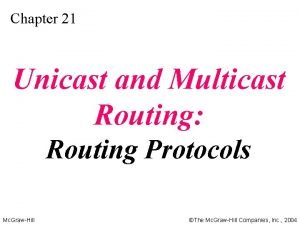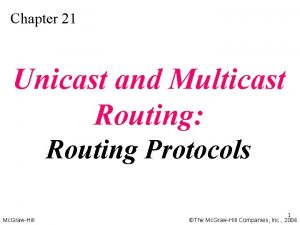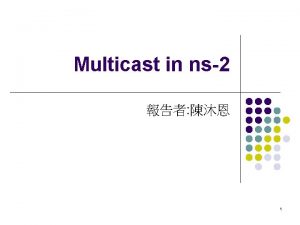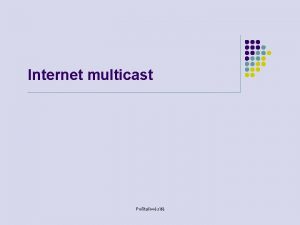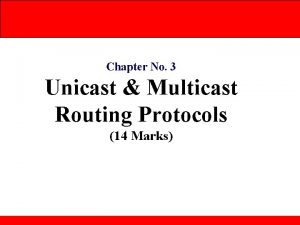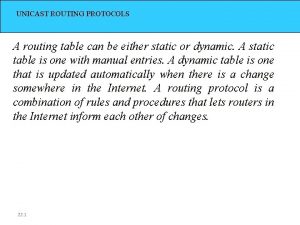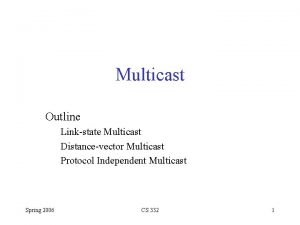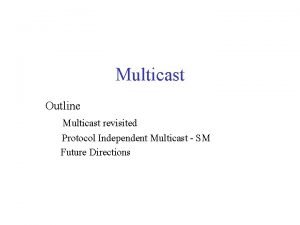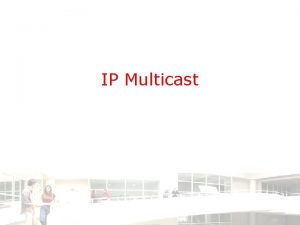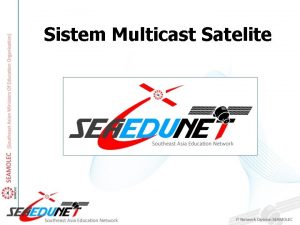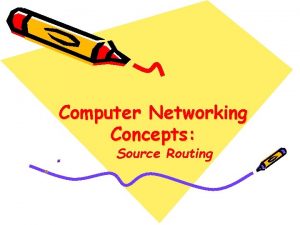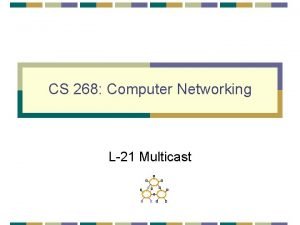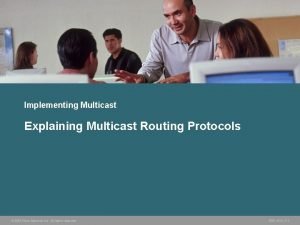L20 Multicast Multicast Routing Unicast one source to
















































































- Slides: 80

L-20 Multicast

Multicast Routing Unicast: one source to one destination Multicast: one source to many destinations Two main functions: Efficient data distribution Logical naming of a group 2

Overview What/Why Multicast IP Multicast Service Basics Multicast Routing Basics DVMRP Reliability Congestion Control Overlay Multicast Publish-Subscribe 3

Multicast – Efficient Data Distribution Src 4

Multicast Router Responsibilities Learn of the existence of multicast groups (through advertisement) Identify links with group members Establish state to route packets Replicate packets on appropriate interfaces Routing entry: Src, incoming interface List of outgoing interfaces 5

Logical Naming Single name/address maps to logically related set of destinations Destination set = multicast group How to scale? Single name/address independent of group growth or changes 6

Multicast Groups Members are the intended receivers Senders may or may not be members Hosts may belong to many groups Hosts may send to many groups Support dynamic creation of groups, dynamic membership, dynamic sources 7

Scope Groups can have different scope LAN (local scope) Campus/admin scoping TTL scoping Concept of scope important to multipoint protocols and applications 8

Example Applications Broadcast audio/video Push-based systems Software distribution Web-cache updates Teleconferencing (audio, video, shared whiteboard, text editor) Multi-player games Server/service location Other distributed applications 9

Overview What/Why Multicast IP Multicast Service Basics Multicast Routing Basics DVMRP Reliability Congestion Control Overlay Multicast Publish-Subscribe 10

IP Multicast Architecture Service model Hosts Host-to-router protocol (IGMP) Routers Multicast routing protocols (various) 11

IP Multicast Service Model (rfc 1112) Each group identified by a single IP Groups may be of any size Members of groups may be located address anywhere in the Internet Members of groups can join and leave at will Senders need not be members Group membership not known explicitly Analogy: Each multicast address is like a radio frequency, on which anyone can transmit, and to which anyone can tune-in. 12

IP Multicast Addresses Class D IP addresses 224. 0. 0. 0 – 239. 255 1 110 Group ID How to allocated these addresses? Well-known multicast addresses, assigned by IANA Transient multicast addresses, assigned and reclaimed dynamically, e. g. , by “sdr” program 13

IP Multicast Service Sending – same as before Receiving – two new operations Join-IP-Multicast-Group(group-address, interface) Leave-IP-Multicast-Group(group-address, interface) Receive multicast packets for joined groups via normal IP-Receive operation 14

Multicast Scope Control – Small TTLs TTL expanding-ring search to reach or find a nearby subset of a group s 1 2 3 15

Multicast Scope Control – Large TTLs Administrative TTL Boundaries to keep multicast traffic within an administrative domain, e. g. , for privacy or resource reasons The rest of the Internet An administrative domain TTL threshold set on interfaces to these links, greater than the diameter of the admin. domain 16

Overview What/Why Multicast IP Multicast Service Basics Multicast Routing Basics DVMRP Reliability Congestion Control Overlay Multicast Publish-Subscribe 17

IP Multicast Architecture Service model Hosts Host-to-router protocol (IGMP) Routers Multicast routing protocols (various) 18

Multicast Routing Basic objective – build distribution tree for multicast packets Multicast service model makes it hard Anonymity Dynamic join/leave 19

Routing Techniques Flood and prune Begin by flooding traffic to entire network Prune branches with no receivers Examples: DVMRP, PIM-DM Unwanted state where there are no receivers Link-state multicast protocols Routers advertise groups for which they have receivers to entire network Compute trees on demand Example: MOSPF Unwanted state where there are no senders 20

Routing Techniques Core based protocols Specify “meeting place” aka core Sources send initial packets to core Receivers join group at core Requires mapping between multicast group address and “meeting place” Examples: CBT, PIM-SM 21

Shared vs. Source-based Trees Source-based trees Separate shortest path tree for each sender DVMRP, MOSPF, PIM-DM, PIM-SM Shared trees Single tree shared by all members Data flows on same tree regardless of sender CBT, PIM-SM 22

Source-based Trees Router S Source R Receiver R R S R 23

A Shared Tree Router S Source R Receiver R R S RP R S R 24

Shared vs. Source-Based Trees Source-based trees Shortest path trees – low delay, better load distribution More state at routers (per-source state) Efficient for in dense-area multicast Shared trees Higher delay (bounded by factor of 2), traffic concentration Choice of core affects efficiency Per-group state at routers Efficient for sparse-area multicast Which is better? extra state in routers bad! is 25

Overview What/Why Multicast IP Multicast Service Basics Multicast Routing Basics DVMRP Reliability Congestion Control Overlay Multicast Publish-Subscribe 26

Distance-Vector Multicast Routing DVMRP consists of two major components: A conventional distance-vector routing protocol (like RIP) A protocol for determining how to forward multicast packets, based on the routing table DVMRP router forwards a packet if The packet arrived from the link used to reach the source of the packet (reverse path forwarding check – RPF) If downstream links have not pruned the tree 27

Example Topology G G S G 28

Broadcast with Truncation G G S G 29

Prune G G Prune (s, g) S Prune (s, g) G 30

Graft G G G Report (g) Graft (s, g) S Graft (s, g) G 31

Steady State G G G S G 32

Overview What/Why Multicast IP Multicast Service Basics Multicast Routing Basics DVMRP Reliability Congestion Control Overlay Multicast Publish-Subscribe 33

Implosion Packet 1 is lost All 4 receivers request a resend Resend request S S 1 2 R 1 R 2 R 3 R 2 R 4 R 3 R 4 34

Retransmission Re-transmitter Options: sender, other receivers How to retransmit Unicast, multicast, scoped multicast, retransmission group, … Problem: Exposure 35

Exposure Packet 1 does not reach R 1; Receiver 1 requests a resend Resend request Packet 1 resent to all 4 receivers S Resent packet 1 2 R 1 1 1 R 2 R 3 S R 2 R 4 R 3 R 4 36

Ideal Recovery Model Packet 1 reaches R 1 but is lost before reaching other Receivers Only one receiver sends NACK to the nearest S or R with packet Resend request S Resent packet 1 2 R 1 S 1 Repair sent only to those that need packet R 1 1 R 2 R 3 R 2 R 4 R 3 R 4 37

SRM Originally designed for wb Receiver-reliable NACK-based Every member may multicast retransmission NACK or 38

SRM Request Suppression Packet 1 is lost; R 1 requests resend to Source and Receivers Resend request S Packet 1 is resent; R 2 and R 3 no longer have to request a resend Resent packet 1 2 X 1 R 1 R 2 R 3 S Delay varies by distance R 2 R 3 X X 39

Deterministic Suppression 3 d d data Time 2 d d nack 3 d repair = Sender = Repairer d 4 d d = Requestor Delay = C 1 d. S, R 40

SRM Star Topology Packet 1 is lost; All Receivers request resends Resend request S Packet 1 is resent to all Receivers Resent packet S 1 2 X R 2 R 3 1 R 4 R 2 R 3 R 4 Delay is same length 41

SRM: Stochastic Suppression 0 d d Time data 1 repair session msg d 2 NACK d 3 2 d = Sender Delay = U[0, D 2] d. S, R = Repairer = Requestor 42

SRM (Summary) NACK/Retransmission suppression Delay before sending Delay based on RTT estimation Deterministic + Stochastic components Periodic session messages Full reliability Estimation of distance matrix among members 43

What’s Missing? Losses at link (A, C) causes retransmission to the whole group Only retransmit to those members who lost the packet [Only request from the nearest responder] S 0 0 B A 0. 99 C 0 0 D Sender E 0 F Receiver 44

Local Recovery Different techniques in various Application-level hierarchy Fixed v. s. dynamic TTL scoped multicast Router supported systems 45

Overview What/Why Multicast IP Multicast Service Basics Multicast Routing Basics DVMRP Reliability Congestion Control Overlay Multicast Publish-Subscribe 46

Multicast Congestion Control What if receivers have very different bandwidths? Send at max? Send at min? Send at avg? 100 Mb/s R 100 Mb/s S ? ? ? Mb/s 1 Mb/s R 1 Mb/s 56 Kb/s R R 47

Video Adaptation: RLM Receiver-driven Layered Multicast Layered video encoding Each layer uses its own mcast group On spare capacity, receivers add a layer On congestion, receivers drop a layer Join experiments used for shared learning 48

Layered Media Streams R 2 R 1 10 Mbps S R 10 Mbps 512 Kbps R R 1 joins layer 1, joins layer 2 joins layer 3 R 2 join layer 1, join layer 2 fails at layer 3 128 Kbps R 3 joins layer 1, fails at layer 2 49

Drop Policies for Layered Multicast Priority Packets for low bandwidth layers are kept, drop queued packets for higher layers Requires router support Uniform (e. g. , drop tail, RED) Packets arriving at congested router are dropped regardless of their layer Which is better? Intuition vs. reality! 50

RLM Intuition 51

RLM Intuition Uniform Better incentives to well-behaved users If oversend, performance rapidly degrades Clearer congestion signal Allows shared learning Priority Can waste upstream resources Hard to deploy RLM approaches optimal operating point Uniform is already deployed Assume no special router support 52

RLM Join Experiment Receivers periodically try subscribing to higher layer If enough capacity, no congestion, no drops Keep layer (& try next layer) If not enough capacity, congestion, drops Drop layer (& increase time to next retry) What about impact on other receivers? 53

Join Experiments Layer 4 3 2 1 Time 54

RLM Scalability? What happens with more receivers? Increased frequency of experiments? More likely to conflict (false signals) Network spends more time congested Reduce # of experiments per host? Takes longer to converge Receivers coordinate to improve behavior 55

Overview What/Why Multicast IP Multicast Service Basics Multicast Routing Basics DVMRP Reliability Congestion Control Overlay Multicast Publish-Subscribe 56

Supporting Multicast on the Internet Application ? IP ? At which layer should multicast be implemented? Network Internet architecture 57

IP Multicast MIT Berkeley UCSD routers end systems multicast flow CMU Highly efficient Good delay 58

End System Multicast MIT 1 MIT Berkeley MIT 2 UCSD CMU 1 CMU 2 Berkeley MIT 1 Overlay Tree MIT 2 UCSD CMU 1 CMU 2 59

Potential Benefits Over IP Multicast Quick deployment All multicast state in end systems Computation at forwarding points simplifies support for higher level functionality MIT 1 Berkeley MIT 2 UCSD CMU 1 CMU 2 60

Concerns with End System Multicast Self-organize recipients into multicast delivery overlay tree Must be closely matched to real network topology to be efficient Performance Multicast concerns compared to IP Increase in delay Bandwidth waste (packet duplication) Berkeley UCSD MIT 1 MIT 2 Berkeley UCSD CMU 1 IP Multicast CMU 2 MIT 1 MIT 2 CMU 1 End System Multicast CMU 2 61

Coordination: Cooperative group communication Scribe: Tree-based group management Multicast, anycast primitives Scalable: large numbers of groups, members, wide range of members/group, dynamic membership [IEEE JSAC ’ 02] 62

Cooperative group communication Operations: create(g) join(g) leave(g) multicast(g, m) anycast(g, m) • group. Id g mapped to n 0 • decentralized membership • robust, scalable nodes g: n 1, n 2 n 0 g n 1 g: n 3, n 4 n 2 g n 3 g n 4 63

Scribe group. Id Proximity spa Join(group. Id) 64

Respecting forwarding capacity The tree structure described may not respect maximum capacities Scribe's push-down fails to resolve the problem because a leaf node in one tree may have children in another tree 65

Parent location algorithm Node adopts prospective child If too many children, choose one to reject: First, look for one in stripe without shared prefix Otherwise, select node with shortest prefix match Orphan locates new parent in up to two steps: Tries former siblings with stripe prefix match Adopts or rejects using same criteria; continue pushdown Use the spare capacity group 66

The spare capacity group If orphan hasn't found parent yet, anycasts to spare capacity group Group contains all nodes with fewer children than their forwarding capacity Anycast returns nearby node, which starts a DFS of the spare capacity group tree, sending first to a child. . . 67

Spare capacity group (cont. ) At each node in the search: If node has no children left to search, check whether it receives a stripe the orphan seeks If so, verifies that the orphan is not an ancestor (which would create a cycle) If both tests succeed, the node adopts the orphan May leave spare capacity group If either test fails, back up to parent (more DFS. . . ) 68

A spare capacity example 69

Problems Imposing bandwidth constraints on Scribe can result in: High tree depth non-DHT links Observed Cause: mismatch between id space and node bandwidth constraints 70

Overview What/Why Multicast IP Multicast Service Basics Multicast Routing Basics DVMRP Reliability Congestion Control Overlay Multicast Publish-Subscribe 71

Publish-Subscribe P/S service is also known as event service Publishers role : Publishers generate event data and publishes them Subscribers role : Subscribers submit their subscriptions and process the events received P/S service: It’s the mediator/broker that routes events from publishers to interested subscribers 72

Publish/Subscribe Want champions league football news REAL MADRID 42 MARSEILLE Subscribe Publish Publication Want weather news for Lancaster Publish/Subscribe Service Weather Lancaster : sunny intervals min 11°C max 20°C Subscription Want Traff ic update fo r junction A 6 Subscriber Publisher 73

Key attributes of P/S communication model The publishing entities and subscribing entities are anonymous The publishing entities and subscribing entities are highly de-coupled Asynchronous communication model The number of publishing and subscribing entities can dynamically change without affecting the entire system 74

Key functions implemented by P/S service Event filtering (event selection)- The process which selects the set of subscribers that have shown interest in a given event Event routing (event delivery) – The process of routing the published events from the publisher to all interested subscribers 75

Subject based vs. Content based Subject based: Generally also known as topic based, group based or channel based event filtering. Here each event is published to one of these channels by its publisher A subscriber subscribes to a particular channel and will receive all events published to the subscribed channel. Simple process for matching an event to subscriptions 76

Subject based vs. Content based: More flexibility and power to subscribers, by allowing to express as an arbitrary query over the contents of the event. E. g. Notify me of all stock quotes of IBM from New York stock exchange if the price is greater than 150 Added complexity in matching an event to subscriptions 77

Event routing The basic P/S system consists of many event publishers, an event broker (or mediator) and many subscribers. An event publisher generates an event in response to some change it monitors The events are published to an event broker which matches events against all subscriptions forwarded by subscribers in the system. Event broker system could have either a single event broker or multiple distributed event brokers coordinating among themselves 78

Event routing C 1, C 2, C 3 are subscriptions of S 1, S 2, S 3 respectively P C 1 P Event broker system C 2 S 1 S 2 P C 3 P OR Single broker P- Event publisher S – Event subscriber S 3 Cluster of cooperating brokers 79

Basic elements of P/S model Event data Structure Types model Subscription model Filter language Scope (subject, content, context) General challenge Expressiveness vs. Scalability 80
 Ethernet unicast multicast y broadcast
Ethernet unicast multicast y broadcast Unicast
Unicast Unicast multicast broadcast address example
Unicast multicast broadcast address example Broadcast vs unicast vs multicast
Broadcast vs unicast vs multicast Unicast vs multicast
Unicast vs multicast Phantom graph
Phantom graph Write a detailed note on unicast routing protocols
Write a detailed note on unicast routing protocols What is unicast routing
What is unicast routing Broadcast and multicast routing
Broadcast and multicast routing Reservoir routing and channel routing
Reservoir routing and channel routing Static routing and dynamic routing
Static routing and dynamic routing Hydrologic routing and hydraulic routing
Hydrologic routing and hydraulic routing Comparison of clock routing and power routing
Comparison of clock routing and power routing Source routing attack
Source routing attack Source routing
Source routing Tera unicast
Tera unicast Unicast
Unicast Virtual port-channel
Virtual port-channel Unicast
Unicast Wired lans
Wired lans Floating static route
Floating static route Global unicast
Global unicast One god one empire one emperor
One god one empire one emperor One one one little dogs run
One one one little dogs run One king one law one faith
One king one law one faith One god one empire one emperor
One god one empire one emperor Ford one plan
Ford one plan See one do one teach one
See one do one teach one One price policy
One price policy Structure of twelfth night
Structure of twelfth night Studiendekanat uni bonn
Studiendekanat uni bonn Asean tourism strategic plan
Asean tourism strategic plan Asean one vision one identity one community
Asean one vision one identity one community Broadcasting
Broadcasting Apa itu multicast
Apa itu multicast What is multicast communication in distributed system
What is multicast communication in distributed system Rfp check
Rfp check Request reply protocol in distributed system
Request reply protocol in distributed system Anycast vs multicast
Anycast vs multicast Multicast traceroute
Multicast traceroute Overlay multicast
Overlay multicast Multicast
Multicast Order of events
Order of events Multicast
Multicast Gggsg
Gggsg Multicast
Multicast Multicast
Multicast Protocolo igmp
Protocolo igmp Bier multicast
Bier multicast Bimodal multicast
Bimodal multicast Calico multicast
Calico multicast Tads hisd
Tads hisd Sourceamerica ability one
Sourceamerica ability one Panday (2005 tv series)
Panday (2005 tv series) Department of labor career one stop
Department of labor career one stop Ability one source
Ability one source Tritonroute
Tritonroute Wrp routing protocol
Wrp routing protocol Contoh perhitungan routing sheet
Contoh perhitungan routing sheet Cisco srv6
Cisco srv6 Rumor routing
Rumor routing Routing statyczny
Routing statyczny Routing overlays
Routing overlays Tabel routing static
Tabel routing static Tabel routing
Tabel routing Path vector routing
Path vector routing Rumour routing
Rumour routing Vector algorithm
Vector algorithm Routing area update
Routing area update Routing tabelle
Routing tabelle Precision queue vs skill groups
Precision queue vs skill groups Ortec routing and dispatch
Ortec routing and dispatch Fungsi network
Fungsi network Responsibility of network layer
Responsibility of network layer Intelligent customer routing
Intelligent customer routing Lar routing protocol
Lar routing protocol Igrp configuration in packet tracer
Igrp configuration in packet tracer Routing and switching protocols
Routing and switching protocols Routing table longest prefix match
Routing table longest prefix match Eth2r
Eth2r Interplay between routing and forwarding
Interplay between routing and forwarding



